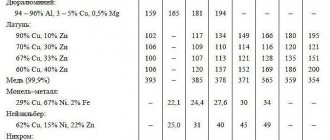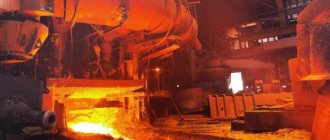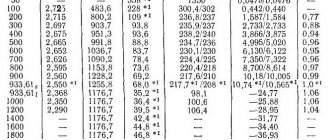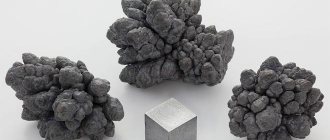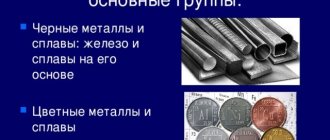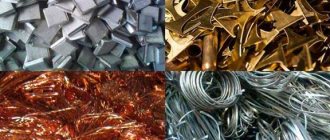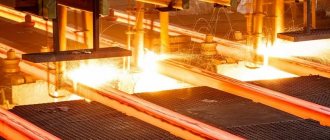Thermal conductivity coefficient of stainless steel
The thermal conductivity of stainless steel is relatively low compared to other alloys. The material is widely used in aggressive environments and as elements for architectural structures. It is often used for facades of buildings, furnaces and conveyors in production. The advantage of low thermal conductivity is high energy efficiency and stability.
If the thermal conductivity coefficient of carbon type steel is within 45 W/(m·K), then the thermal conductivity coefficient of stainless steel is only about 15 W/(m·K). The ability of an alloy to transfer heat is influenced by its composition, as well as the surrounding temperature environment. When purchasing stainless steel products, it is very important to pay due attention to this criterion.
Thermal conductivity of aluminum and steel
If you compare the thermal conductivity of aluminum and steel, it is important to start from the conditions of their planned operation. The thermal conductivity of aluminum at typical room temperature is about 236 W/(m deg). In view of this, the material is often used for the production of radiators and heat sinks.
Aluminum melts at a temperature of 660 °C, and important properties of the material are significantly lost. The indicators largely depend on physical parameters, for example, density. Today, alloys of aluminum with copper, silicon and zinc are in demand.
According to technological features they are divided into:
- Foundries;
- Deformable.
Thermal conductivity of cast iron and steel
Both materials are an alloy of carbon and iron. They are widely used both in industry and in everyday life. Steel is characterized by increased hardness and strength, while cast iron is lightweight and has a lower melting point. Steel is easier to process due to its lower carbon content (compared to cast iron).
The thermal conductivity of cast iron and steel is very important and almost every buyer pays great attention to this indicator. The thermal conductivity of alloys, unlike heat capacity indicators, cannot be determined using the mixing rule. But it is only possible to establish the influence of individual elements on the thermal conductivity of cast iron only approximately.
Need high-quality steel?
Choose a material with suitable properties on our website and place your order! Our assortment includes materials for a wide variety of purposes!
conclusions
When the task is to buy stainless steel and the thermal conductivity of the material is of serious importance, it is important to pay attention to its other characteristics. It is necessary to take into account the composition of the alloy, the temperature environment at the place of operation and other equally important components. Our company’s specialists are always ready to help you with the choice of steel, providing personal advice.
The low thermal conductivity of stainless steel can be a significant, if not the main, advantage of the material. When planning a purchase, pay attention to all specified technical indicators. And our employees will always be happy to give you comprehensive answers to additional questions.
has been successfully operating and developing on the Ukrainian rolled metal market since 2003. In our assortment of items there will certainly be an option that meets your important criteria for your needs. We value the choice of our customers and exercise high quality control of the goods!
Source
What does thermal conductivity depend on?
Studying the ability of heat transfer by metal products, it was revealed that thermal conductivity depends on:
- type of metal;
- chemical composition;
- porosity;
- sizes.
Metals have different crystal lattice structures, and this can change the thermal conductivity of the material. For example, in steel and aluminum, the structural features of microparticles affect differently the rate of transfer of thermal energy through them.
Read also: How to solder copper and brass
The thermal conductivity coefficient can have different values for the same metal when the exposure temperature changes. This is due to the fact that different metals have different melting degrees, which means that under other environmental parameters, the properties of the materials will also differ, and this will affect thermal conductivity.
Thermal conductivity of steel and cast iron
The table shows the thermal conductivity values of steel and cast iron.
The thermal conductivities of steels are given for the following types: carbon, low- and medium-alloyed, heat-resistant and heat-resistant stainless steels, spring steels, steels for castings, tool steels, depending on temperature.
The thermal conductivity of steel in the table is presented for various grades in the temperature range from -263 to 1200°C.
The average thermal conductivity of carbon steels (type steel 08, steel 3, steel 20) at room temperature is 50...90 W/(m deg). The thermal conductivity of stainless, heat-resistant and heat-resistant martensitic steels lies in the range from 30 to 45 W/(m deg). The thermal conductivity of stainless steels (type 12Х18Н9Т) of the austenitic class is in the range from 12 to 22 W/(m deg).
Application
The state of aggregation of materials has a distinctive structure of molecules and atoms. This is what has a great influence on metal products and their properties, depending on their purpose.
The different chemical composition of components and parts made of iron allows them to have different thermal conductivities. This is due to the structure of metals such as cast iron, steel, copper and aluminum. The porosity of cast iron products promotes slow heating, and the density of the copper structure, on the contrary, accelerates the heat transfer process. These properties are used for rapid heat removal or gradual heating of inert products. An example of using the properties of metal products is:
- kitchen utensils with various properties;
- pipe soldering equipment;
- irons;
- rolling and sliding bearings;
- plumbing equipment for heating water;
- heating devices.
Copper tubes are widely used in radiators of automobile cooling systems and air conditioners used in everyday life. Cast iron radiators retain heat in the apartment, even with an inconsistent supply of coolant at the required temperature. And radiators made of aluminum contribute to the rapid transfer of heat to the heated room.
Read also: Adjusting the oil supply to the chainsaw chain
When high temperatures occur as a result of friction of metal surfaces, it is also important to take into account the thermal conductivity of the product. In any gearbox or other mechanical equipment, the ability to remove heat will allow the mechanism parts to maintain strength and not be subject to destruction during operation. Knowledge of the heat transfer properties of various materials will allow you to competently use certain alloys of non-ferrous or ferrous metals.
Before working with various metals and alloys, you should study all the information regarding their basic characteristics. Steel is the most common metal and is used in various industries. An important indicator is thermal conductivity, which varies over a wide range and depends on the chemical composition of the material and many other indicators.
Thermophysical properties of steel depending on temperature
The following thermophysical properties of steel of various grades are presented:
The table shows the thermophysical properties and areas of application of the following steels:
1. Unalloyed steels, low- and medium-alloy pearlitic steels: steel 08, steel 10, 15, 20, 35, 45, U8, 65G, 13N2ХА, 15ХА, 15Х, 20Х, 30ХГС, 30ХГСА, 15ХМ, 15ХМА, 30ХМ, 30ХМА , X11MF, X12VIMF, 12X1MF, 25X2MFA, 15L, 20L, 25L, 30L, 35L, 40L, 45L, 50L, 55L.
2. Stainless steels, heat-resistant and heat-resistant steels of martensitic, martensitic-ferritic and ferritic classes: Kh5M, 1Kh13 (EZh1, Zh1), 2Kh1213MBFR (EI993), 4Kh13 (EZh4, Zh4), Kh12V2MF (EI756).
3. Stainless steels, heat-resistant and heat-resistant steels of the austenitic class: Kh18N9T (EYa1T), Kh18N9TL, Kh18N12B (Kh18N11B, EI402), Kh23N18 (EI417), Kh17N13M2T (Kh18N13M2T, EI448), Kh16N13M2B (EI680), 3Х19Н9МВБТ (ЭИ572), Х16Н25М6 ( EI395), KhN35VT (EI612, EI612K), KhN35VTR (EI725, EI725A), KhN35VMT (EI692), Kh22N26, VZh100.
The following table shows the change in thermal conductivity of various grades of steel and Fe due to thermal aging.
The dimensions of steel properties are expressed in SI units.
- Physical quantities. Directory. A. P. Babichev, N. A. Babushkina, A. M. Bratkovsky and others; Ed. I.S. Grigorieva, E. Z. Meilikhova. - M.: Energoatomizdat, 1991. - 1232 p.
- Gerasimov V.V., Monakhov A.S. Materials of nuclear technology: Textbook for universities. — 2nd edition, revised. and additional - M.: Energoizdat, 1982. - 288 p.
- Kazantsev E.I. Industrial furnaces. Reference manual for calculations and design.
- Brand of steels and alloys. 2nd ed., add. and corr. A. S. Zubchenko, M. M. Koloskov, Yu. V. Kashirsky and others. Under the general editorship. A. S. Zubchenko - M.: Mechanical Engineering, 2003. 784 p.: ill.
Source
Importance in everyday life and production
Why is it important to consider thermal conductivity? A similar value is indicated in various tables for each metal and is taken into account in the following cases:
- In the manufacture of various heat exchangers. Heat is one of the important carriers of energy. It is used to provide comfortable living conditions in residential and other premises. When creating heating radiators and boilers, it is important to ensure rapid and complete heat transfer from the coolant to the end consumer.
- In the manufacture of outlet elements. You can often encounter a situation where you need to remove heat rather than supply it. An example is the case of heat removal from the cutting edge of a tool or gear teeth. To ensure that the metal does not lose its basic performance qualities, rapid removal of thermal energy is ensured.
- When creating insulating layers. In some cases, the material should not conduct thermal energy transfer. For such operating conditions, a metal is selected that has a low heat conductivity coefficient.
The indicator under consideration is determined when testing under various conditions. As previously noted, the thermal conductivity coefficient may depend on the operating temperature. Therefore, the tables indicate several of its values.
Thermal conductivity of steel at different temperatures
So what is thermal conductivity? From a physics point of view, thermal conductivity
– this is the molecular transfer of heat between directly contacting bodies or particles of the same body with different temperatures, in which the energy of movement of structural particles (molecules, atoms, free electrons) is exchanged.
To put it simply, thermal conductivity
is the ability of a material to conduct heat. If there is a temperature difference inside the body, then thermal energy moves from the hotter part of the body to the colder part.
Heat transfer occurs due to the transfer of energy when molecules of a substance collide. This happens until the temperature inside the body becomes the same.
This process can occur in solid, liquid and gaseous substances.
In practice, for example in construction for the thermal insulation of buildings, another aspect of thermal conductivity is considered, associated with the transfer of thermal energy. Let's take an “abstract house” as an example.
In the “abstract house” there is a heater that maintains a constant temperature inside the house, say, 25 ° C. The temperature outside is also constant, for example, 0 °C.
It is quite clear that if you turn off the heater, then after a while the house will also be 0 °C. All the heat (thermal energy) will go through the walls to the street.
To maintain the temperature in the house at 25 ° C, the heater must be constantly running. The heater constantly creates heat, which constantly escapes through the walls to the street.
Coefficient of thermal conductivity
The amount of heat that passes through the walls (and according to science, the intensity of heat transfer due to thermal conductivity) depends on the temperature difference (in the house and outside), on the area of the walls and the thermal conductivity of the material from which these walls are made.
To quantify thermal conductivity, there is a coefficient of thermal conductivity of materials . This coefficient reflects the property of a substance to conduct thermal energy. The higher the thermal conductivity coefficient of a material, the better it conducts heat.
If we are going to insulate a house, then we need to choose materials with a small value of this coefficient. The smaller it is, the better. Nowadays, the most widely used materials for insulating buildings are mineral wool insulation and various foam plastics.
A new material with improved thermal insulation properties – Neopor – is gaining popularity.
The thermal conductivity coefficient of materials is designated by the letter ? (Greek small letter lambda) and is expressed in W/(m2*K). This means that if you take a brick wall with a thermal conductivity coefficient of 0.67 W/(m2*K), a thickness of 1 meter and an area of 1 m2.
, then with a temperature difference of 1 degree, 0.67 watts of thermal energy will pass through the wall. If the temperature difference is 10 degrees, then 6.7 watts will pass. And if, with such a temperature difference, the wall is made 10 cm, then the heat loss will already be 67 watts.
More details about the methodology for calculating heat loss in buildings can be found here.
It should be noted that the values of the thermal conductivity coefficient of materials are indicated for a material thickness of 1 meter. To determine the thermal conductivity of a material for any other thickness, the thermal conductivity coefficient must be divided by the desired thickness, expressed in meters.
In building codes and calculations the concept of “thermal resistance of a material” is often used. This is the reciprocal of thermal conductivity. If, for example, the thermal conductivity of foam plastic 10 cm thick is 0.37 W/(m2*K), then its thermal resistance will be equal to 1 / 0.37 W/(m2*K) = 2.7 (m2*K)/ Tue
Thermal conductivity coefficient of materials
The table below shows the values of the thermal conductivity coefficient for some materials used in construction.
| Material | Coeff. warm W/(m2*K) |
| Alabaster slabs | 0,470 |
| Aluminum | 230,0 |
| Asbestos (slate) | 0,350 |
| Fibrous asbestos | 0,150 |
| Asbestos cement | 1,760 |
| Asbestos cement slabs | 0,350 |
| Asphalt | 0,720 |
| Asphalt in floors | 0,800 |
| Bakelite | 0,230 |
| Concrete on crushed stone | 1,300 |
| Concrete on sand | 0,700 |
| Porous concrete | 1,400 |
| Solid concrete | 1,750 |
| Thermal insulating concrete | 0,180 |
| Bitumen | 0,470 |
| Paper | 0,140 |
| Light mineral wool | 0,045 |
| Heavy mineral wool | 0,055 |
| Cotton wool | 0,055 |
| Vermiculite sheets | 0,100 |
| Woolen felt | 0,045 |
| Construction gypsum | 0,350 |
| Alumina | 2,330 |
| Gravel (filler) | 0,930 |
| Granite, basalt | 3,500 |
| Soil 10% water | 1,750 |
| Soil 20% water | 2,100 |
| Sandy soil | 1,160 |
| The soil is dry | 0,400 |
| Compacted soil | 1,050 |
| Tar | 0,300 |
| Wood - boards | 0,150 |
| Wood – plywood | 0,150 |
| Hardwood | 0,200 |
| Chipboard | 0,200 |
| Duralumin | 160,0 |
| Reinforced concrete | 1,700 |
| Wood ash | 0,150 |
| Limestone | 1,700 |
| Lime-sand mortar | 0,870 |
| Iporka (foamed resin) | 0,038 |
| Stone | 1,400 |
| Multilayer construction cardboard | 0,130 |
| Foamed rubber | 0,030 |
| Natural rubber | 0,042 |
| Fluorinated rubber | 0,055 |
| Expanded clay concrete | 0,200 |
| Silica brick | 0,150 |
| Hollow brick | 0,440 |
| Silicate brick | 0,810 |
| Solid brick | 0,670 |
| Slag brick | 0,580 |
| Siliceous slabs | 0,070 |
| Brass | 110,0 |
| Ice 0°C | 2,210 |
| Ice -20°С | 2,440 |
| Linden, birch, maple, oak (15% humidity) | 0,150 |
| Copper | 380,0 |
| Mipora | 0,085 |
| Sawdust - backfill | 0,095 |
| Dry sawdust | 0,065 |
| PVC | 0,190 |
| Foam concrete | 0,300 |
| Polystyrene foam PS-1 | 0,037 |
| Polyfoam PS-4 | 0,040 |
| Polystyrene foam PVC-1 | 0,050 |
| Foam resopen FRP | 0,045 |
| Expanded polystyrene PS-B | 0,040 |
| Expanded polystyrene PS-BS | 0,040 |
| Polyurethane foam sheets | 0,035 |
| Polyurethane foam panels | 0,025 |
| Lightweight foam glass | 0,060 |
| Heavy foam glass | 0,080 |
| Glassine | 0,170 |
| Perlite | 0,050 |
| Perlite-cement slabs | 0,080 |
| Sand 0% moisture | 0,330 |
| Sand 10% moisture | 0,970 |
| Sand 20% humidity | 1,330 |
| Burnt sandstone | 1,500 |
| Facing tiles | 1,050 |
| Thermal insulation tile PMTB-2 | 0,036 |
| Polystyrene | 0,082 |
| Foam rubber | 0,040 |
| Portland cement mortar | 0,470 |
| Cork board | 0,043 |
| Cork sheets are lightweight | 0,035 |
| Cork sheets are heavy | 0,050 |
| Rubber | 0,150 |
| Ruberoid | 0,170 |
| Slate | 2,100 |
| Snow | 1,500 |
| Scots pine, spruce, fir (450…550 kg/cub.m, 15% humidity) | 0,150 |
| Resinous pine (600…750 kg/cub.m, 15% humidity) | 0,230 |
| Steel | 52,0 |
| Glass | 1,150 |
| Glass wool | 0,050 |
| Fiberglass | 0,036 |
| Fiberglass | 0,300 |
| Wood shavings - stuffing | 0,120 |
| Teflon | 0,250 |
| Paper roofing felt | 0,230 |
| Cement boards | 1,920 |
| Cement-sand mortar | 1,200 |
| Cast iron | 56,0 |
| Granulated slag | 0,150 |
| Boiler slag | 0,290 |
| Cinder concrete | 0,600 |
| Dry plaster | 0,210 |
| Cement plaster | 0,900 |
| Ebonite | 0,160 |
